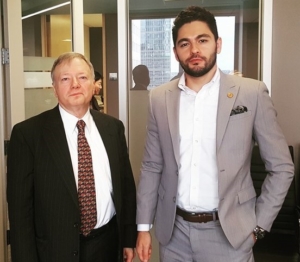
From left: Jan Lyons, Senior Advisor for Economics, U.S. Dept. of Homeland Security, USCIS, and Nawaf Alfaouri, Economic Development Specialist, Greenfield Advisors.
Created by Congress in 1990 as a means to stimulate the economy and create jobs, the EB-5 Immigrant Investor Program has become the most popular residency program in the world, in part because it is relatively inexpensive. Comparable programs in Australia, the U.K., or Canada have investment requirements of $1 million to $5 million.
The United States Citizenship and Immigration Services (USCIS) estimates that since 2012 at least $8.7 billion has been invested in the U.S. economy and 35,150 jobs created through the EB-5 program. The program issues a maximum of 10,000 green cards a year and 90% of the applications come from China.
However successful, in recent years the program has been rife with fraud, both foreign and domestic. With potentially more than $1 million changing hands in every transaction, developers, lawyers, and applicants all have strong incentives to exploit the system. This is why Nawaf Alfaouri, Economic Development Specialist at Greenfield Advisors, attended a briefing on the steps the USCIS is taking to address the issue.
Visa Classification Description
USCIS administers the EB-5 program to stimulate the U.S. economy through job creation and capital investment by foreign investors. Under a program initially enacted as a pilot in 1992, and regularly reauthorized since then, investors may also qualify for EB-5 classification by investing through regional centers designated by USCIS based on proposals for promoting economic growth. On May 5, 2017, the President signed Public Law 115-31, extending the regional center program through Sept. 30, 2017.
USCIS policy on EB-5 adjudications is contained in Volume 6, Part G of the USCIS Policy Manual.
All EB-5 investors must invest in a new commercial enterprise that meets these conditions:
- Established after Nov. 29, 1990, or
- Established on or before Nov. 29, 1990, that is:
1. Purchased and the existing business is restructured or reorganized in such a way that a new commercial enterprise results, or
2. Expanded through the investment so that at least a 40-percent increase in the net worth or number of employees occurs
Commercial enterprise means any for-profit activity formed for the ongoing conduct of lawful business including, but not limited to:
- A sole proprietorship
- Partnership (whether limited or general)
- Holding company
- Joint venture
- Corporation
- Business trust, or
- Other entity, which may be publicly or privately owned.
Job Creation Requirements
An EB-5 investor must invest the required amount of capital in a new commercial enterprise that will create full-time positions for at least 10 qualifying employees.
- For a new commercial enterprise not located within a regional center, the full-time positions must be directly created by the new commercial enterprise to be counted. This means that the new commercial enterprise (or its wholly owned subsidiaries) must itself be the employer of the qualifying employees.
- For a new commercial enterprise located within a regional center, the full-time positions can be created either directly or indirectly by the new commercial enterprise.
- Direct jobs are those jobs that establish an employer-employee relationship between the new commercial enterprise and the persons it employs.
- Indirect jobs are those jobs held outside of the new commercial enterprise but that are created as a result of the new commercial enterprise.
Capital Investment Requirements
Capital means cash, equipment, inventory, other tangible property, cash equivalents, and indebtedness secured by assets owned by the alien entrepreneur, provided that the alien entrepreneur is personally and primarily liable and that the assets of the new commercial enterprise upon which the petition is based are not used to secure any of the indebtedness. All capital shall be valued at fair-market value in United States dollars. Assets acquired, directly or indirectly, by unlawful means (such as criminal activities) shall not be considered capital for the purposes of section 203(b)(5) of the Act.
Note: The immigrant investor must establish that he or she is the legal owner of the capital invested. Capital can include the immigrant investor’s promise to pay (a promissory note) under certain circumstances.
Required minimum investments are:
- General. The minimum qualifying investment in the United States is $1 million.
- Targeted Employment Area (High Unemployment or Rural Area). The minimum qualifying investment either within a high-unemployment area or rural area in the United States is $500,000.
A targeted employment area is an area that, at the time of investment, is a rural area or an area which has experienced unemployment of at least 150 percent of the national average rate.
A rural area is any area not within either a metropolitan statistical area (as designated by the Office of Management and Budget) or the outer boundary of any city or town having a population of 20,000 or more according to the most recent decennial census of the United States.
Petition/Application Process
- File Form I-526, Immigrant Petition by Alien Entrepreneur.
- Following approval of the Form I-526 petition, either:
- File Form I-485, Application to Register Permanent Residence or Adjust Status, with USCIS to adjust status to a conditional permanent resident within the United States, or
- File DS-260, Application for Immigrant Visa and Alien Registration, with the U.S. Department of State to obtain an EB-5 visa abroad to seek admission to the United States.
Upon the approval of a Form I-485 application or upon admission into the United States with an EB-5 immigrant visa, the EB-5 investor and derivative family members will be granted conditional permanent residency for a 2-year period.
Future Outlook

Jan Lyons, Senior Advisor for Economics, U.S. Dept. of Homeland Security, USCIS, discussing the future of the EB-5 program.
The Department of Homeland Security is currently considering new regulations (initially proposed by the Obama administration) that aim to curb at least some of the program’s abuses. Changes include raising the minimum investment to $1.35 million for TEA projects and to $1.8 million for non-TEA projects, standardizing the definition of TEAs, and giving USCIS sole authority to designate TEAs. Jan Lyons also discussed the establishment of a new commission to further audit EB-5 applications, USCIS obtaining broader powers to perform site visits, and sharing information with government agencies like the NSA to prevent fraud.
The call for reform later developed into a call for the complete elimination of the EB-5 program. Senators Dianne Feinstein (D-Calif.) and Chuck Grassley (R-Iowa), ranking member and chairman of the Senate Judiciary Committee, have introduced legislation to eliminate the EB-5 investor visa program.
The lower investment level is intended to spur investments in rural and high-unemployment areas. However, the program lacks a reliable or verifiable way to measure job creation. Furthermore, many of the wealthiest areas in America have been inaccurately designated as “high-unemployment” in order to allow investors to obtain a green card for the smaller $500,000 investment.
The Department of Homeland Security’s inspector general in September 2014 released a report detailing these problems, and the Government Accountability Office also discussed problems with the program in an August 2015 report.
“The EB-5 program is inherently flawed. It says that U.S. citizenship is for sale. It is wrong to have a special pathway to citizenship for the wealthy while millions wait in line for visas. I agree that the time has come to end EB-5,” said Senator Feinstein. “The Securities and Exchange Commission has filed charges in case after case of fraud connected to this troubled program. I look forward to working with Chairman Grassley to advance our legislation.”
“The EB-5 program has been rife with fraud and national security weaknesses. It has also strayed from Congress’ original intent to spur economic development in rural and depressed areas. For years, I’ve worked with bipartisan colleagues in good faith to reform it. Unfortunately, despite its many flaws, EB-5 proponents are apparently content with the status quo, and that’s unacceptable. I was hoping that it would not come to this point, but absent serious efforts to bring about reforms, we need to take the necessary steps to wind down the program and completely mitigate fraud, abuse and threats to our security,” Senator Grassley said.
While these abuses are serious, a complete elimination of the EB-5 program is highly unlikely, according to Lyons of the USCIS. He provided speculations that legislation will soon be passed to ensure the EB-5 program is permanent without an expiry date, an issue that has plagued the program since its conception. In the months prior to the EB-5 program expiration, USCIS has been flooded with hundreds of applications, many completed with haste and thus not meeting the standards of the USCIS. This creates two issues: 1) a back log of applications, forcing congress to extend the deadline temporarily; and 2) higher accounts of fraud or inaccurate applications, costing the USCIS time and money when following up with applicants.
The program could soon be granted a permanent place with the USCIS. The solution most talked about seems to be focused on expanding the powers of USCIS and to better track the job creation of the EB-5.






Some really nice stuff on this website , I like it.
Great info, thanks for the share!